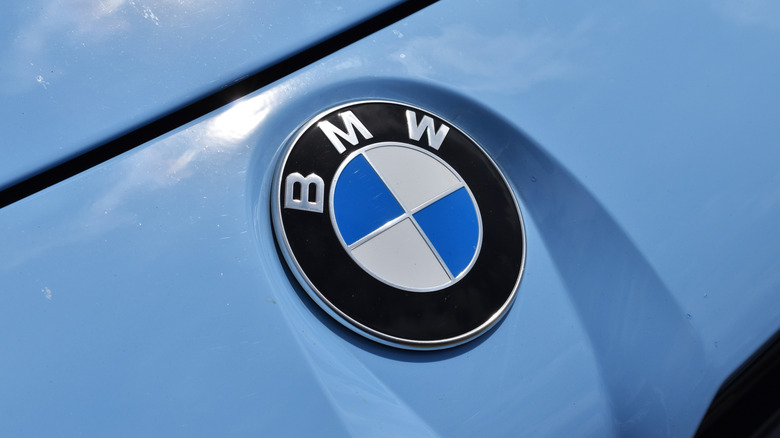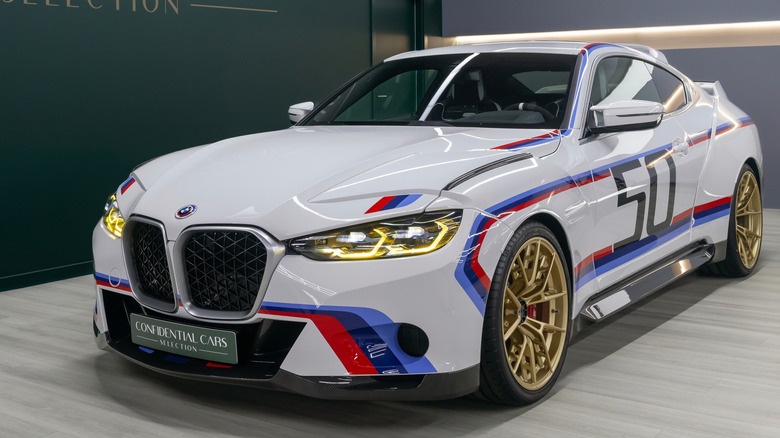What Do The Numbers On BMW Cars Mean?
There's a lot more that goes into the development of a line of vehicles than just the engineering. While that's one of the most important steps, there's also a whole lot of creativity involved, from the colors the rides are to be sold in to the names they'll go by. Throughout the years, some lasting, iconic examples have come around, while other car names leaned more in the awkward and absurd direction. As for those under the BMW umbrella, they have been designated differently than how most automotive manufacturers go about it, and it can seem quite strange at first glance.
For BMW vehicles, they're given a specific number instead of a more straightforward name. The first number reveals the car's model series and size, with larger numbers indicating a make. The following two numbers stand for the displacement in the car's engine, which in the modern era is measured in kilowatts. Finally, the letter on the end indicates the drive technology. Gasoline cars bear an "i," diesel are "d," and "e" means you're looking at a plug-in hybrid. All-wheel drive vehicles are given the xDrive tag, while sDrive is representative of front or rear-wheel drive.
As if this wasn't enough information to pack into a single BMW's name, there's a bit more. Some vehicles take on added characteristics that are presented in their identifying code.
There are some less commonly-used BMW car code elements to know
Using the aforementioned decoding method will get you where you need to be in terms of understanding most BMW models. At the same time, there are some you're likely to encounter, both current and of yesteryear, that come with additional numerals to wrap your head around. Much like the ones gone over before, though, they're not too difficult to understand. For older, classic BMWs — including those you can probably afford — you might see Ci, meaning either coupe or sedan, Compact for three-door hatchback versions of the BMW3 series, and e, before representing hybrid technology, signified cars that pack an added punch when it comes to torque and RPM.
As far as modern BMW rides, there are a few more added designations. Competition is added to cars that have a sportier design than their contemporaries, while CS has been used for Coupe Sport and Competition Sport over the years. There's a variation on this as well, CSL, which stands for Coupe Sport Leichtbau and denotes lightweight Coupe Sport vehicles. GT stands for Gran Turismo, L is for vehicles with a longer wheelbase than normal, and ti is Turismo Internazionale, or Touring International. Alongside it is tii, or Turismo Internationale Iniezione, translated as Touring International Injection.
With this knowledge in mind, it becomes far less confusing to look at a BMW vehicle's "name." Still, it's impossible not to ask the question, why does one of the major luxury car brands in the world handle its naming in such an odd way?
BMW naming has evolved over the years
The history of BMW dates back to 1916, when the company came to fruition as Bayerische Flugzeugwerke AG. Just as it didn't decide on the name of the brand right out of the gate, BMW didn't have its modern vehicle naming method until decades into its existence as an automobile manufacturer. The BMW 3/15 PS — PS meaning Pferdestärke, 15 representing the car's 15 horsepower, and 3 representing the car's 3 taxable horsepower — arrived in 1929 as BMW's first car, and just before World War II, BMW cars were designated with a 300 number. Later models were part of the Neue Klasse, or new class, which is where the likes of the BMW 501, 1500, and more come in up until the 1960s.
On the whole, these were clear efforts to designate BMW models in ways that made sense. They told you about the capabilities of the car in question, while also differentiating from other rides in BMW's lineup, such as the 100 series airplanes and 200 series motorcycles. Still, they weren't perfect, and BMW higher-ups were well aware of this, so they went back to the drawing board. Ultimately, the decision was made to work with the streamlined, universal, and informative code naming system seen today. Once you know how it works, it's easy to understand regardless of where you're from.
Say what you will about BMW's unorthodox naming system, but there's no denying its uniqueness. It was thoroughly developed to be as informational as it is succinct.


